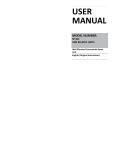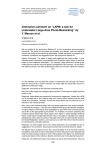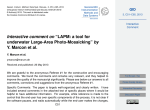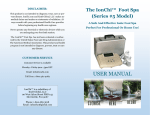Download ST-2550 High Current IV Tracer FAQs
Transcript
ST-2550 High Current IV Tracer FAQs Is the ST-2550 a TLP? No, the ST-2550 uses a different method of producing the IV curve than a TLP (Transmission Line Pulser) does. How does the ST-2550 differ from a TLP? A TLP uses a series of very short (100 nanoseconds or less) voltage pulses with current limited by a resistance. The pulse voltage is increased for successive pulses. After settling, the voltage across the DUT (Device Under Test) and the current through the DUT are recorded for each pulse. The ST-2550 applies a single IEC 61000-4-5 compliant surge pulse to the DUT. During the surge pulse the voltage across the DUT and the current through the DUT are sampled as the current increases and then decreases. What are some of the advantages of one method versus the other? The very short pulses of the TLP are about the same duration as ESD (ElectroStatic Discharge) events. For that reason a TLP is an excellent tool to use to characterize the behavior of devices subjected to ESD stresses. The surge pulses of the ST-2550 are about 20 µs long and meet the requirements of the IEC 61000-4-5 surge test. The ST-2550 is the tool to use to characterize the behavior of devices subjected to surges. Although the power in the DUT from the ST-2550 is higher than that of a TLP due to the longer pulse width, it is still low enough that in many cases the ST-2550 can be used in place of a TLP to characterize ESD behavior. Plotting a curve using the ST-2550 is much faster than a TLP, needing less than one second to take and display an IV curve. This compares to several minutes for a TLP. The short measuring time makes the ST-2550 ideal for quickly testing a large quantity of devices. What is the theory of operation? Briefly, the ST-2550 uses an IEC 61000-4-5 compliant pulse generator to stress the device. This pulse is applied to the DUT while a high speed digitizer records the voltage across the DUT and the current through the DUT, producing the IV curve. How much energy is the DUT subjected to? That depends on the breakdown voltage of the DUT and the peak pulse current. As an example, for a device such as a 1N6373 TVS (Transient Voltage Suppressor) that has a 7.5 V breakdown, plotting it out to 18 A will subject the DUT to about 2025 µJ. For comparison purposes, the 18 A, 100 ns pulse of a TLP will subject the same DUT to about 13.5 µJ and the 18 A, 1 ms pulse of a conventional curve tracer will subject the DUT to about 135,000 µJ. You can see that while the energy from the ST2550 is larger than that of a TLP it is still less than 2% that of a conventional curve tracer. Many devices that would be damaged by the energy of a conventional curve tracer may be safely traced using the ST-2550. How does the cabling affect the curve? Because the ST-2550 sees the DUT in series with the cables, both the resistance and the inductance of the cabling can affect the results. For this reason the ST-2550 has routines to characterize the cables and remove the effects of the cables from the final IV plot. This is referred to as de-embedding the cables. Moving the cables changes their inductance, so it is important to characterize the cables in their final configuration. What are the limits on allowed cabling? As the cable resistance and inductance increases, the peak current through the DUT is reduced. Practically speaking, about 1 Ω and about 2 µH are good limits. Can the ST-2550 be used with a probe station? Yes. Keep in mind that the stress current can be many amperes; keep the cables as short as possible and use appropriate probes. Do I need to own a copy of LabVIEW? No. The ST-2550 software comes with a run-time version of LabVIEW. Load the ST-2550 software on your PC and it is ready to run. Can I modify the program? Yes, but you will need your own copy of LabVIEW to do this. The source code is provided so you can make any modifications you like, such as customizing the plot titles with your company’s name. What if something happens to you? This is a good question that you should ask! I admit at the moment Marum Consulting is a one person company and if anything should incapacitate me your ST2550 will be an “orphan”. Shipped with every ST-2550 will be everything an electronic technician needs to perform standard maintenance and even repairs should the unit fail. The high speed digitizer is a commercial, replaceable unit and the custom PC boards are thru-hole construction. Schematics and source code are provided. What is provided with the ST-2550? The following items are included: ST-2550 hardware Power supply Standard test leads USB cable Run-time control software LabVIEW source code for the run-time software User’s manual Calibration instructions Theory of operation Schematic of the hardware If the ST-2550 breaks, how are repairs handled? Using the provided documentation you can probably make repairs yourself onsite. If you prefer you can ship the ST-2550 to me and I will repair it. What is the warrantee? There is a 90 day warrantee against any manufacturing defects. How is the ST-2550 calibrated? Calibration is straightforward. Instructions are provided and calibration can be performed by whoever calibrates your other test equipment. What are the computer requirements? Any PC running Windows XP or newer is suitable. A display size of 1366*768 or greater is recommended. What are the power requirements? Part of the ST-2550 circuitry is USB powered; the high current pulse generator is powered by a supplied 5 V, 2 A power adaptor.











